The celebrated Mr. K shines a spotlight on the behind-the-scenes staffers who brought you the comics you love…
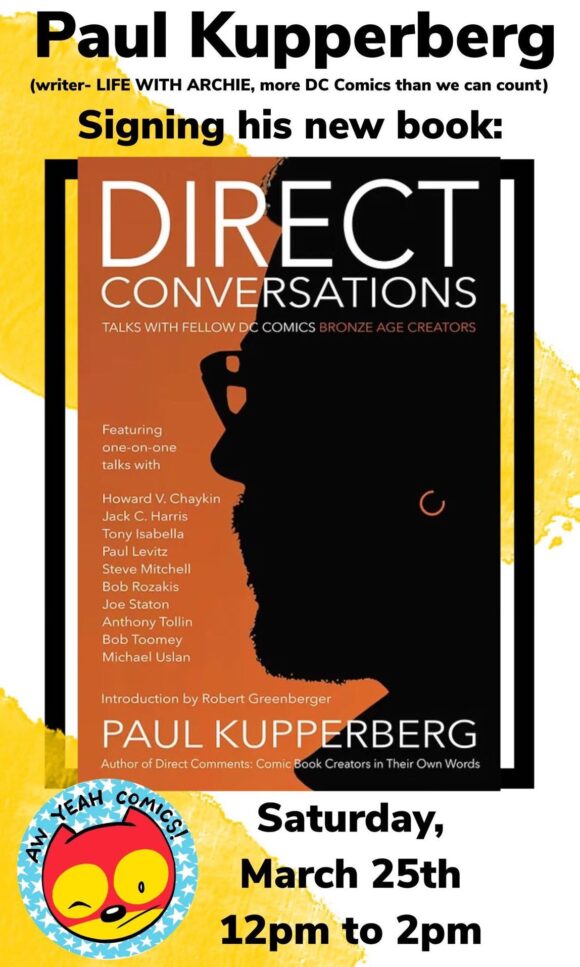
By PAUL KUPPERBERG
If you’re in the vicinity of Harrison, NY, Saturday, March 25 between noon and 2 pm, I’m going to be signing Direct Conversations: Talks with Fellow DC Comics Bronze Age Creators and other bits of ephemera at Aw Yeah! Comics at 313 Halstead Ave. Hope to see you there!
* * *
In Direct Conversations: Talks with Fellow DC Comics Bronze Age Creators, one-time assistant editor and former company president and publisher Paul Levitz remembered, “(The DC Comics offices of the early 1970s) wasn’t a terrible environment to be in. And it was an easy environment to learn in. … Imagine the opportunity to work in a place with 35 people, and one out of every five of them will become Hall of Famers in the industry. Bear that in mind. Two out of the five were in drudge jobs that mostly involved moving stuff along, so maybe half of the people with any responsibilities would become legends. And never mind all the other people walking in and out of the office. How could you not learn? How could you not grow, surrounded by that many role models of creative success?”
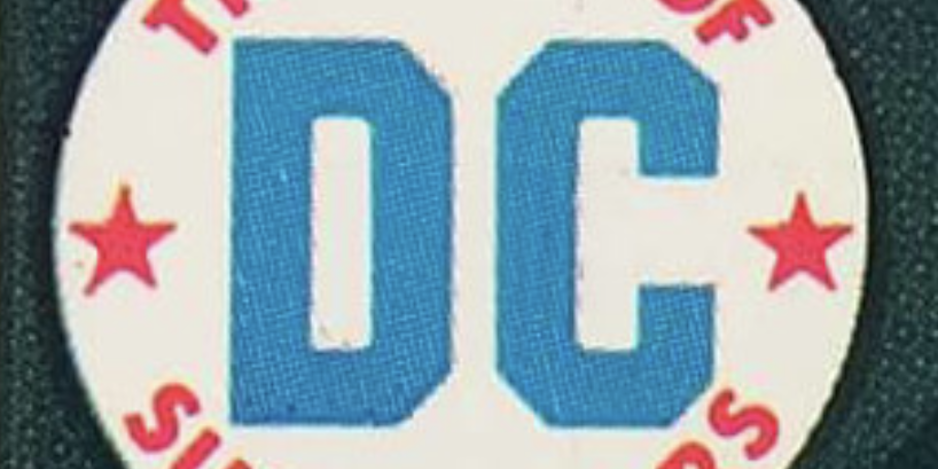
Or, as sports manager Spencer Tracy famously assessed athlete Katharine Hepburn in the 1952 classic Pat and Mike, “Not much meat on her, but what’s there is cherce!” That little company, hidden away on one-third of a floor in midtown Manhattan’s 75 Rockefeller Center was indeed home to a powerful line-up of creatives. The two who were in “drudge jobs” Paul references were company president Sol Harrison and production manager Jack Adler. The other three were Joe Kubert, Joe Orlando, and Julie Schwartz, but that left out a couple of dozen names that, while not legendary, perhaps deserve to be and were, in their own ways, every bit as important as Sol, Jack, and the rest to the history and development of DC Comics.
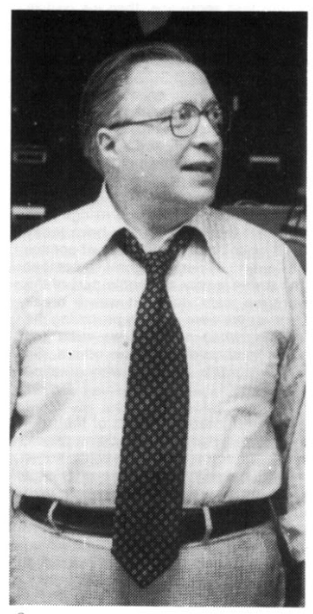
Sol Harrison
Readers of certain ages will likely be familiar with some of the names below in different creative capacities for DC and Marvel (among others), but a lot of people got their start on staff during this pivotal era in comics history. A forgotten source was the “DC Profiles” feature (many of which I wrote) that ran in books during the late 1970s and early 1980s, many documenting hitherto behind-the-scenes personnel. Some of the below found their way into Direct Conversations, but almost all of them got at least a mention in the book. (The short bios below are clipped from the feature “Meet the Woodchucks” in 1974’s The Amazing World of DC Comics #1 (July – August 1974), the first issue of the company’s answer to Marvel’s FOOM, because, again according to Mr. Levitz, “Sol sees what’s going on at Marvel with FOOM and other things. He says, ‘You know… this will be a good opportunity to teach the kids some stuff.’”
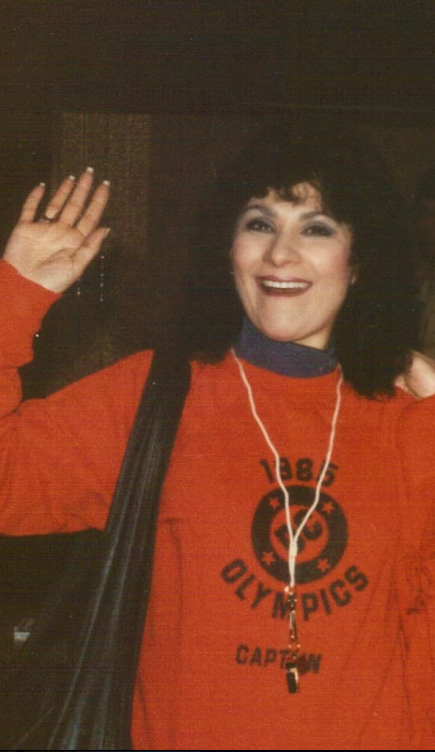
Carol Fein
The kids, as it turned out, learned well. Here then, kids and grown-ups alike, are 13 DC BRONZE AGE STAFFERS YOU SHOULD KNOW MORE ABOUT:
—
JACK ADLER (July 1, 1917 – September 18, 2011) was a founding father of the business. In addition to his work as production manager and later VP of production, Jack was one of the best colorists in comics and was responsible for the look of DC’s covers for years. He developed many of the techniques that made those covers stand out over the competition on the newsstand, including the use of wash tones and covers that integrated art and photographs (often his own; he was also a talented photographer), and was, according to many, a tough mentor. Said Adler-trained colorist Anthony Tollin, “When you were trained by Jack Adler, you were trained to focus attention on what was important on a page and to knock back or kill what wasn’t, to focus the reader’s eye and help keep the story moving. You know, in the real world, you see a lot of bright red chairs, but you better not be making the chair in the background fire engine red unless there’s $10 million in it, and you want it to be the focus of attention. Details like that can ruin a story.”
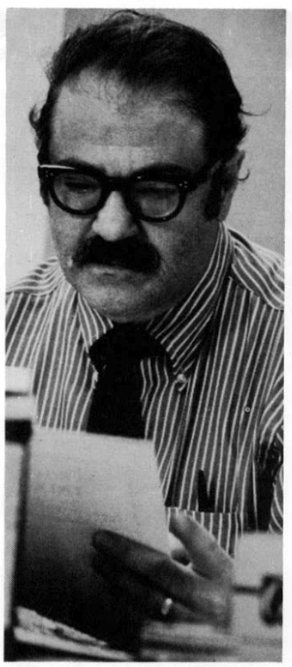
—
LOIS BARKER had been working quietly behind the scenes in comics for years by the time I became aware of her at DC in the early 1970s, guardian, with Milton Snapinn, of DC’s negative library to service foreign publishers and DC’s own reprint needs. Her DC Profile appeared in January 1980.
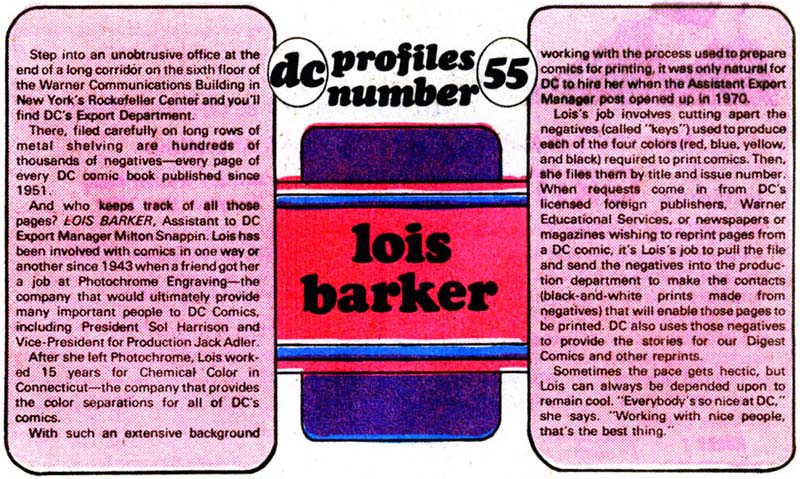
—
MIDGE BREGMAN was a DC Comics fixture for as long as I can remember. Michael Uslan remembers in Direct Conversations: “And let’s not forget the women . . . well, they were called secretaries in those days, but they were practically running the joint. There was Sol’s secretary, Midge Bregman, who was like a combination of second mom and seventh-grade English teacher to me. She was fabulous. She loved everybody. She loved the job. She loved everything that was happening, everything she was doing. She cared about everybody.” Her DC Profile, by Mike Catron, appeared in June 1978.
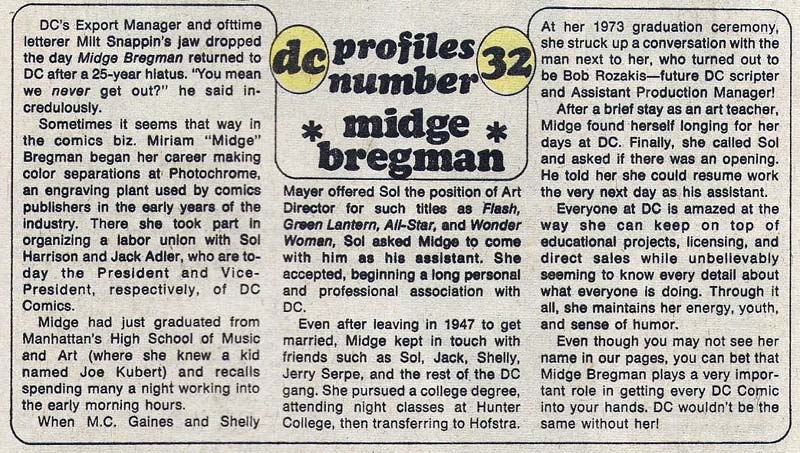
—
SHELLEY EIBER spent almost 42 years at DC working in various areas of production and later as Assistant Manager of DC’s Archiving Services Department, as well as a colorist, retiring in 2015. Her DC Profile appeared in October 1977.
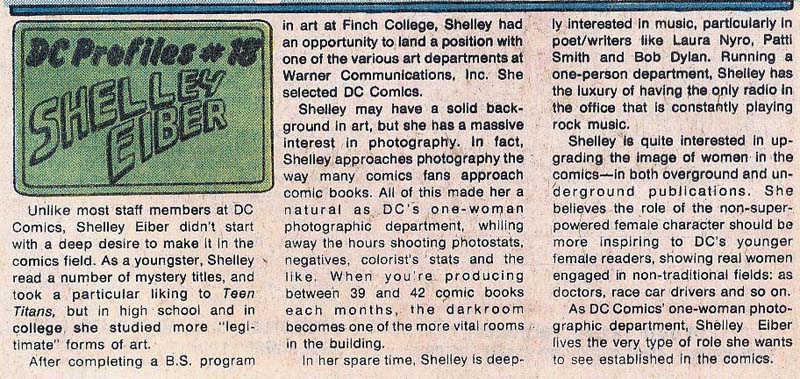
—
CAROL FEIN guarded the doors to publisher Carmine Infantino’s office when I first started hanging around DC in the early 1970s, and a few years later she was back, this time at new publisher Jenette Kahn’s doors. As I recalled in Direct Conversations, “Carol was the best, as long as you stayed on her good side. She was a tough Long Island chick and took crap from nobody.” Her DC Profile, by me, was published in October 1979.
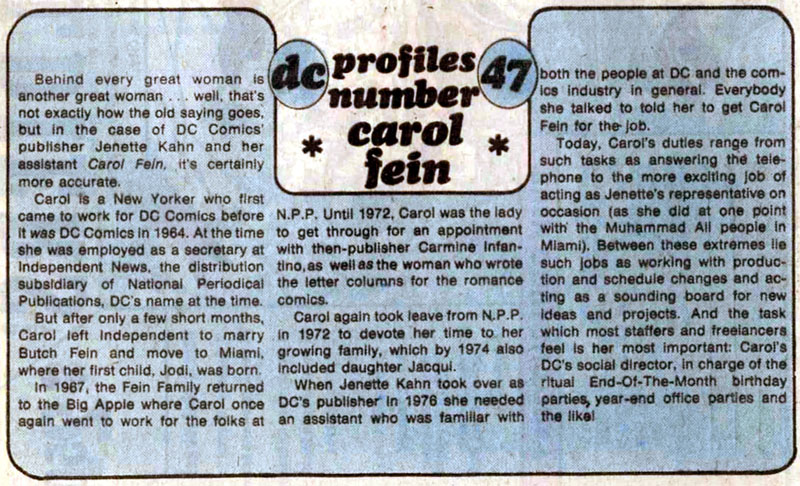
—
MICHAEL FLEISHER (November 1, 1952 – February 2, 2018). Until 1972, Mike Fleisher was Joe Orlando’s assistant editor (that’s when he took the summer off from which he would never return, opening the job to a young Paul Levitz), but he was always a prolific writer with a unique voice. Fleisher was going places creators weren’t going in mainstream comics of the mid-1970s. His coldblooded rendition of the Spectre in Adventure Comics and his creation, the bounty hunter Jonah Hex, remain textbooks on how to do those things right. His life beyond comics is worth checking out. His DC Profile, by Mike Gold, was published in May 1977.
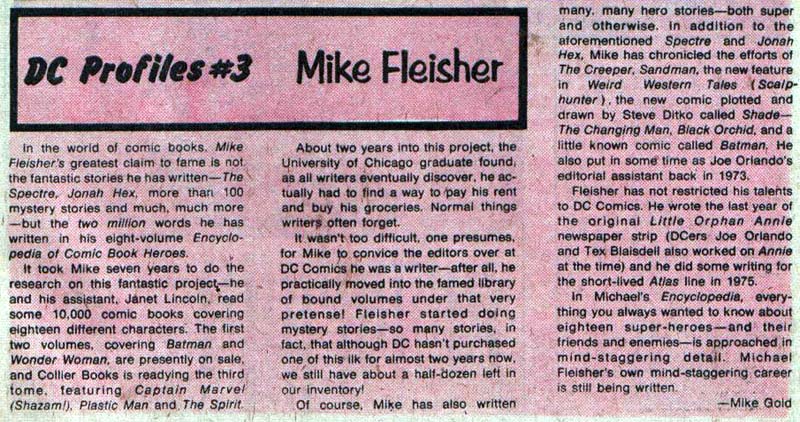
—
CARL GAFFORD (November 23, 1953 – July 13, 2020). He was Gaff, or the Gaff, and I don’t know whether he loved comics or comic fandom more; just because he started working at DC Comics as a proofreader (and later assistant production manager and colorist) he never dropped his “fanac” (fan activities). Gaff was a sort of fannish mentor to me; he owned a ditto machine and was a master ditto stencil cutter who taught me how it was done. Gaff’s best remembered for his seven-year run as colorist on Legion of Super-Heroes beginning in 1981 and on Marvel’s Hanna-Barbera comics in the 1970s.
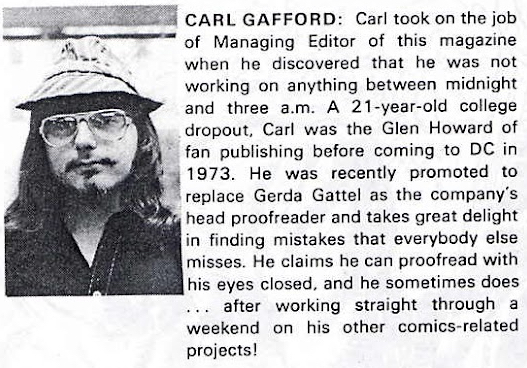
—
SOL HARRISON (1917 – November 19, 1989) wasn’t one of the grown-ups. He was the grown-up at DC Comics! Sol got his start doing color separations for Eastern Color Printing and worked on Famous Funnies, one of the first American comic books. Starting in 1942 he became All-American Comics’ (a predecessor to DC) production manager. He colored over 15 years of DC’s covers. In 1972 he created the tabloid format. In 1973 he was named DC’s VP of Operations, later became president, and retired in 1980.
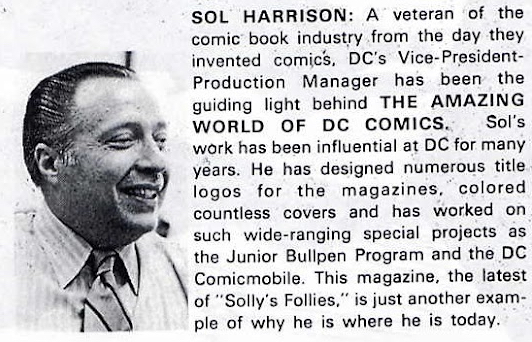
—
BOB LeROSE (June 3, 1921 – August 30, 2006) was, for me, the best of people and the King of Comics! Here’s the DC Profile (published in October of 1978) I wrote of him way back, and there’s more about Bob here, at “The King of Comics”.
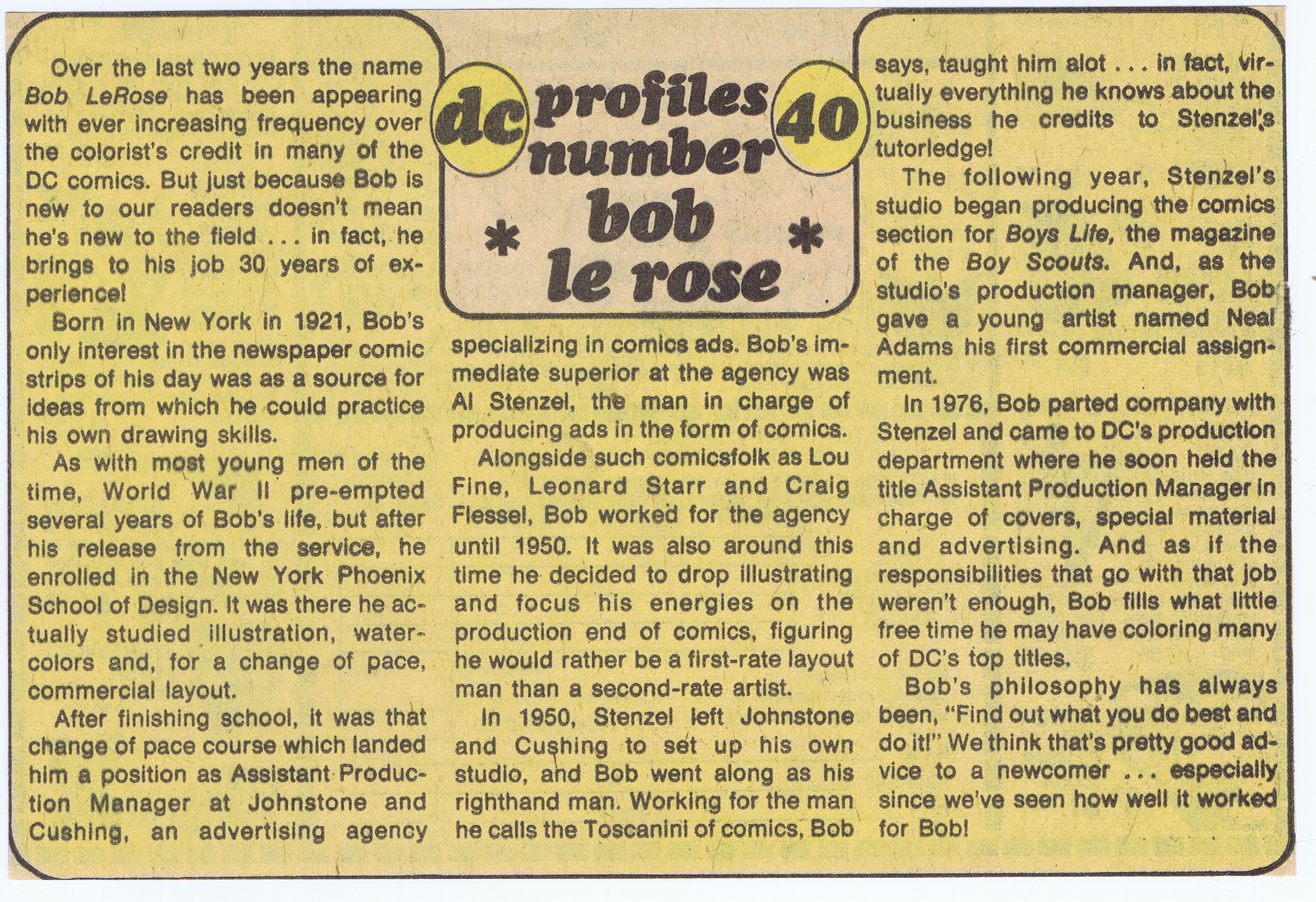
—
JOE LETTERESE (June 19, 1917 – June 3, 1991), former Timely Comics production artist was a DC production regular and letterer by the time I became conscious of him. Bob Rozakis was Joe’s supervisor in later years and told me in Direct Conversations, “Joe used to come in 15 minutes early every day, so he could leave 15 minutes early to make a certain bus. And if we had a day when Sol would announce we were closing at one o’clock, Joe would say, ‘Then I’m leaving at a quarter to one.’ I told him, ‘No, that’s not really the way it works,’ but he insisted that if he came in 15 minutes early, he got to leave 15 minutes early, regardless of the circumstances. He was also firm about the 10 a.m. coffee break. He would stop whatever he was doing—even if he was just about to add the third bar to an ‘E’ in a lettering correction, he’d put down his pen.” His DC Profile was published in November 1979.
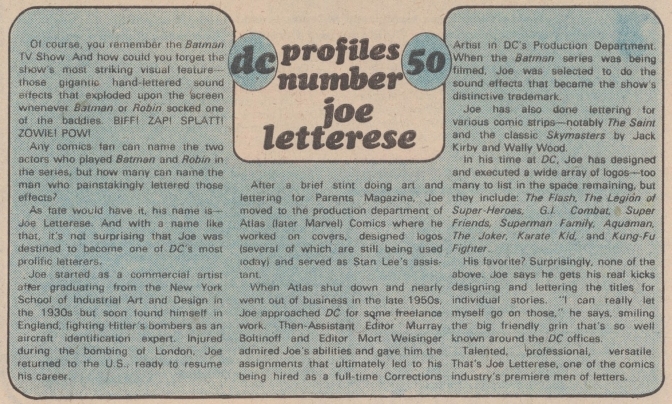
—
BILL MORSE was a name from the production department I’d forgotten until Tony Tollin and Steve Mitchell brought him up. Tony told me, “Bill would go a little crazy on Friday afternoons. And one day, he just jumped up on top of the long white filing cabinets I mentioned before and started doing a monkey walk and ape call. And then, he encouraged the others in the back of production to join in. Bob LeRose … I don’t know if Steve Mitchell was there or not. But I think he even had (staffer) Morris Waldinger making jungle sounds as Bill conducted them all. I was sitting at my desk in front of production, and Sol was in his office talking to his boss, Richard Sarnoff, president of Warner Publishing. When he heard these noises coming from production, he excused himself, walked into production, turned the corner by my desk up front, and saw what was going on. Instead of yelling or getting upset, he just shook his head, turned, and walked out, closing the production department door quietly behind him. He figured it was Friday afternoon and these creative people had to blow off steam, so he left them to it. I consider that Sol Harrison’s finest moment.”
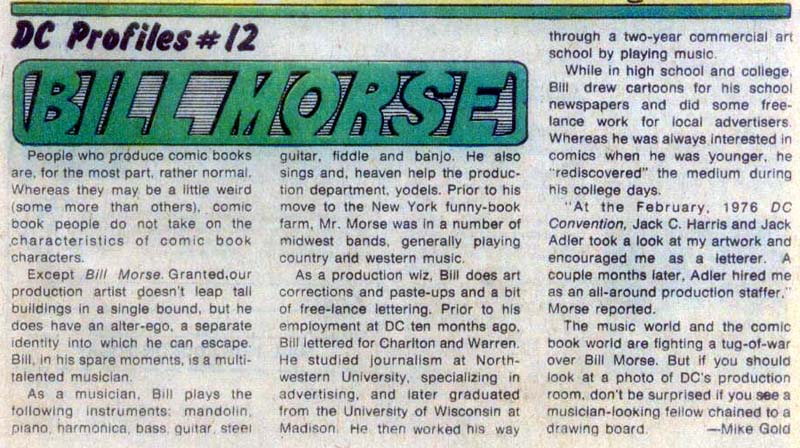
—
BOB ROZAKIS (April 4, 1951) is a ‘Mazing Man with all the Answers. Man. (I think I broke something reaching for those.) Bob was DC’s “Answer Man,” the writer and/or co-creator of the Calculator, Mr. E, the Secret Society of Super-Villains, ‘Mazing Man, and successor to Jack Adler as head of the company’s production department, where he helped usher DC into the modern era of digital color separations, lettering, and pre-press. He also drove the infamous DC Comics Comicmobile in the summer of 1973, as he recalled in Direct Conversations, “It was Sol’s idea to sell new comics from a van, Good Humor ice cream truck–style. Michael Uslan had been driving it around New Jersey, where he lived, but he had to go back to school, so we brought the van out to Long Island, where I lived, to finish out the summer. It was a hassle because what I was doing required a permit, but each township on the island had its own separate permit, so it was a big rigamarole. The summer was over after six weeks, and all our customers were back in school, so I was brought back into the office.”
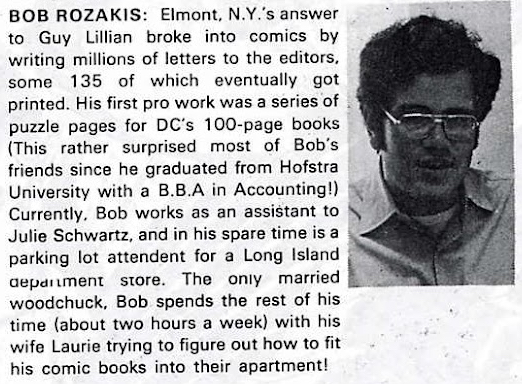
—
MILT SNAPINN was a letterer, a production artist, and the man in charge of DC’s foreign reprints, i.e., getting the proper negatives to the correct foreign publishers with the captions and balloons blanked out so they could be re-lettered in the destination country’s language. What I most remember about Milt is he was grumpy and he was one of Julie Schwartz’s regular lunchtime bridge partners. His DC Profile, by Mike W. Barr, was published in August 1980.
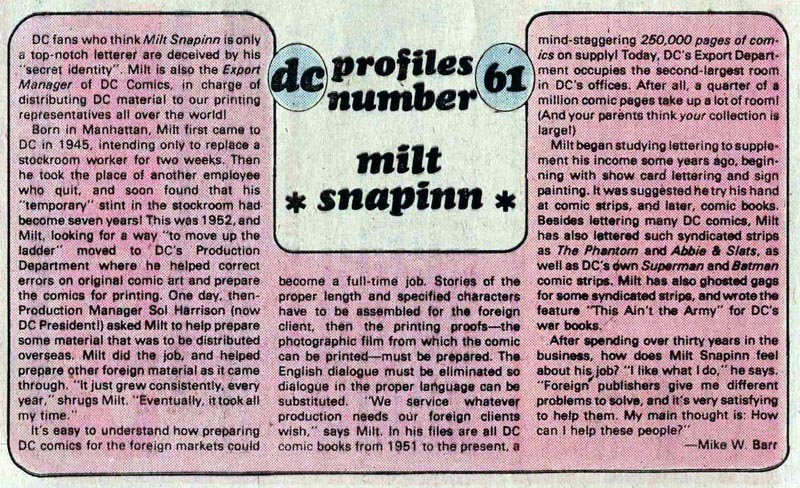
—
MORE
— PAUL KUPPERBERG: My 13 Favorite Comics Discussed in DIRECT CONVERSATIONS. Click here.
— PAUL KUPPERBERG: My 13 Favorite Quotes from DIRECT CONVERSATIONS. Click here.
—
PAUL KUPPERBERG was a Silver Age fan who grew up to become a Bronze Age comic book creator, writer of Superman, the Doom Patrol, and Green Lantern, creator of Arion Lord of Atlantis, Checkmate, and Takion, and slayer of Aquababy, Archie, and Vigilante. He is the Harvey and Eisner Award nominated writer of Archie Comics’ Life with Archie, and his YA novel Kevin was nominated for a GLAAD media award and won a Scribe Award from the IAMTW. Now, as a Post-Modern Age gray eminence, Paul spends a lot of time looking back in his columns for 13th Dimension and in books such as Direct Conversations: Talks with Fellow DC Comics Bronze Age Creators and Direct Comments: Comic Book Creators in Their own Words, available, along with a whole bunch of other books he’s written, by clicking the links below.
Website: https://www.paulkupperberg.net/
Shop: https://www.paulkupperberg.net/shop-1
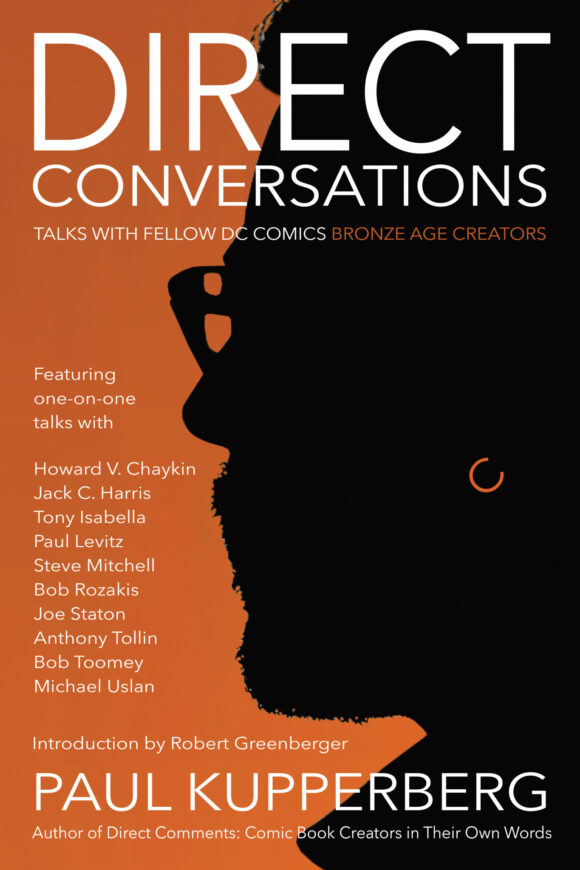

March 24, 2023
I’m not sure Paul K’s math matches Paul L’s original comment. The way I read Levitz, he is saying 1 out of every 5 people among the 35 was a future “Hall of Famer,” whatever that means. So 7 total. Probably includes the 5 that Kupperberg names, plus certainly Denny O’Neil, on staff as an editor in those years, maybe Robert Kanigher depending on whether he was free-lance at that point. Then I think Levitz meant to say 2 out of every 5 were in “drudge jobs” (ouch!), so a total of 14 people, I imagine many of whom are on Kupperberg’s list of 13. That leaves 2 out every 5 as some other category “would become legends” (not Hall of Famer, not “drudge”). So another 14 people, likely including names like E. Nelson Bridwell, or Michael Fleischer from the list above.
March 24, 2023
Oh, I forgot Carmine Infantino, still running DC at that point. Certainly one of the Hall of Famers Levitz mentions. No matter what you think of his tenure as Editorial Director / Publisher, his contributions as an artist certainly merit inclusion in anyone’s Hall of Fame!
March 24, 2023
As Paul L can verify, my math skills were always subpar.
March 24, 2023
I am currently and thoroughly enjoying reading my autographed copy of “Direct Conversations”. I can’t recommend it enough to any fan interested in hearing about some great comic history. Like this List of 13, there is just something special about that era. Reading these stories about these creators and administrative folks begs the question, “How was it all done?”. I have zero background in print or publishing. I’d love to know how these books were produced. To me it seems a lost art that explains the overly sterilized product being produced today. The computer is a tool (I think) that takes way too much away from the creators.
March 24, 2023
I enjoyed Michael Fleisher’s long run on Jonah Hex, but Hex’s creator was John Albano, wasn’t it?
March 24, 2023
Mike Fleisher didn’t create Jonah Hex, although he certainly did write a lot of great stories about him. That character was created by writer John Albano and artist Tony DeZuniga in All-Star Western #10.
And I definitely agree with all the nice things people are saying about Direct Conversations. I’d love to see a sequel.
March 25, 2023
Oh, thank you or this! I remember a lot of these names and this feature that told their stories!
March 25, 2023
So many incredible people. I would have loved to watch Jack Adler doing one of his wash covers. DC should put out a whole book of his work.